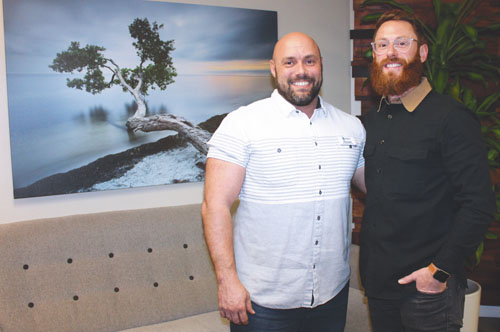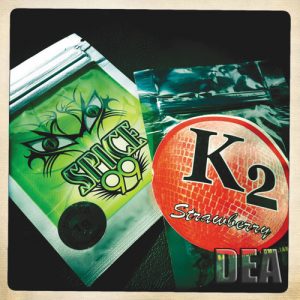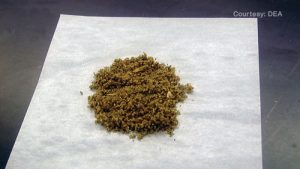A growing concern among Long Beach health care providers, law enforcement and government officials is the growing use of the synthetic opioid fentanyl. The drug, which is adding fuel to the flames of the American opioid crisis, is 80 to 100 times stronger than morphine, according to the U.S. Drug Enforcement Administration. Although originally developed pharmaceutically to care for cancer patients, the drug is also produced illicitly, and is increasingly being added to other drugs such as heroin and cannabis, according to local drug abuse caregivers and city officials.
An academic study on synthetic opioid involvement in U.S. drug overdose deaths between 2010 and 2016 found that “heroin and synthetic opioids (primarily illicit fentanyl) are increasingly implicated in overdoses,” and that “synthetic opioids are increasingly found in illicit drug supplies of heroin, cocaine, methamphetamine, and counterfeit pills.” The study was published in May in the Journal of the American Medical Association.
Although other synthetic drugs are used with more prevalence in Long Beach, particularly the stimulant methamphetamine, local officials said they were currently most concerned by fentanyl because it is often fatal.
“California saw a 57% increase in overdose deaths related to fentanyl in 2017. Opioid abuse was a Midwest and East Coast phenomenon for several years, but it has now hit California,” City Prosecutor Doug Haubert told the Business Journal. “We should prepare to see more deaths related to fentanyl in the near future.”
Haubert added, “Simply touching fentanyl with your bare hands can kill you. It can enter your system through the skin.”
Sgt. Tim Long, who leads the Long Beach Police Department’s (LBPD) drug investigations section, said that synthetic drugs are becoming more commonly used in Long Beach. “Synthetic drugs are growing in popularity because they are more potent than natural drugs; the effects on the user are enhanced, lasting longer and producing a maximum high,” he said in an e-mail to the Business Journal. However, he noted, “Long Beach has not yet experienced an elevated level of detrimental effects as [those] other communities are battling, due to the dedicated resources focused on prevention.”

The most commonly used synthetic drug in Long Beach is methamphetamine, and the “second runner up is fentanyl,” Long said. “Heroin derivatives, opioids, and depressant drugs are becoming more prevalent within local communities. Another synthetic making a small comeback is MDMA (Ecstasy). This synthetic is very popular with college students and youth,” he noted.
Synthetic drug use is not associated with any particular population, Long pointed out. “In the past, drug abuse may have been identified with specific populations. Today, drug abuse affects all walks of life,” he said. “There is no longer a specific population that can be absolutely identified with drug use and addiction. Any community can be affected by drugs today, as evidenced by the nationwide drug abuse epidemic.”
Haubert noted that, as a powerful depressant, fentanyl “slows the respiratory system to the point that it will actually stop, and you will die,” unlike methamphetamine, which acts a stimulant to the body.


Although referred to as synthetic cannabis, the drug pictured is not made with marijuana. Instead, it is manufactured by spraying a concoction of man-made drugs on dried plant material. (Image courtesy of the U.S. Drug Enforcement Administration)
Noah Warren, partner and business development manager of Long Beach-based addiction and mental health treatment center Roots Through Recovery, said that it is easy and cheap to obtain fentanyl illicitly. Of concern to Warren is that he is seeing increasing numbers of patients who are testing positive for fentanyl, but who did not knowingly ingest the drug.
“When you’re buying something on the street, you don’t know what’s in it,” Warren said. “We’re finding that people are doing heroin that is cut with fentanyl. Or they think they are doing benzo[diazepines]s, like Xanax, but they are buying it off the street – and when they come to us they are actually testing positive for fentanyl. The danger in that is the synthetic opioids are so much more potent than . . . what the pharmaceutical companies are creating.”
Warren noted that fentanyl’s effects are so powerful that Narcan, a nasal spray used to revive individuals who have overdosed, sometimes does not work.
Long said the number one risk of synthetic drug abuse is overdose. “Users and addicts underestimate the potency of the drug, wanting a better high, and their body cannot adjust to the strength of the synthetic drug,” he said. “Medical synthetic drugs are designed for extreme applications such as pain management and surgical procedures. Used irresponsible and illegally, synthetic drugs can be deadly.”
Fentanyl is often used legally for in-home hospital care. “A home’s medicine cabinet is the ‘best’ and ‘number one’ source for synthetics drugs. Anyone, such as an immediate family member, house guest, neighbor or child, allowed in the home can be the vehicle for drug removal and theft,” Long said.
“Synthetic drugs are a concern regarding rising crime rates,” Long said. “They do pose a risk to responding police personnel and the public. Synthetic drugs can have abstract or unfamiliar symptoms. Synthetics can produce unfamiliar symptoms appearing to emulate a hallucinogen or various psychoactive behaviors. It greatly depends on the community it is affecting, how easily they are accessed, and the level of usage.”
Another prevalently used synthetic drug in recent years was spice, a synthetic drug meant to stimulate the same brain cell receptors as marijuana, according to the Centers for Disease Control. Typically, spice comes in the form of dried plant materials sprayed with a synthetic concoction of drugs. Before being outlawed in California in 2017, spice was commonly sold in gas station convenient stores and labeled as incense “not for human consumption,” according to Warren.
It is difficult to predict the effects of spice, because its chemical make-up varies from batch to batch, according to the National Institute on Drug Abuse. Spice is known to cause extreme paranoia, hallucinations, anxiety, rapid heart rate, seizures and other detrimental health effects that, in some cases, many also endanger others.
According to Warren, spice has been a problem particularly among teenagers, who would smoke the same amount of the drug as they would marijuana, resulting in psychosis and seizures.
The prevalence of vaping – smoking substances through an e-cigarette – makes it more difficult to know what a person is ingesting and if it is illegal, according to Haubert.
As the city prosecutor, Haubert said, “I am concerned with how difficult it is for law enforcement to prevent the widespread distribution and use of synthetic drugs. Our streets are being flooded with synthetic drugs and there is no easy solution to stopping it.” He continued, “Without a doubt, any time you see an increase in drug use on the streets, you’re going to see an increase in crime in order to feed the habit.”
